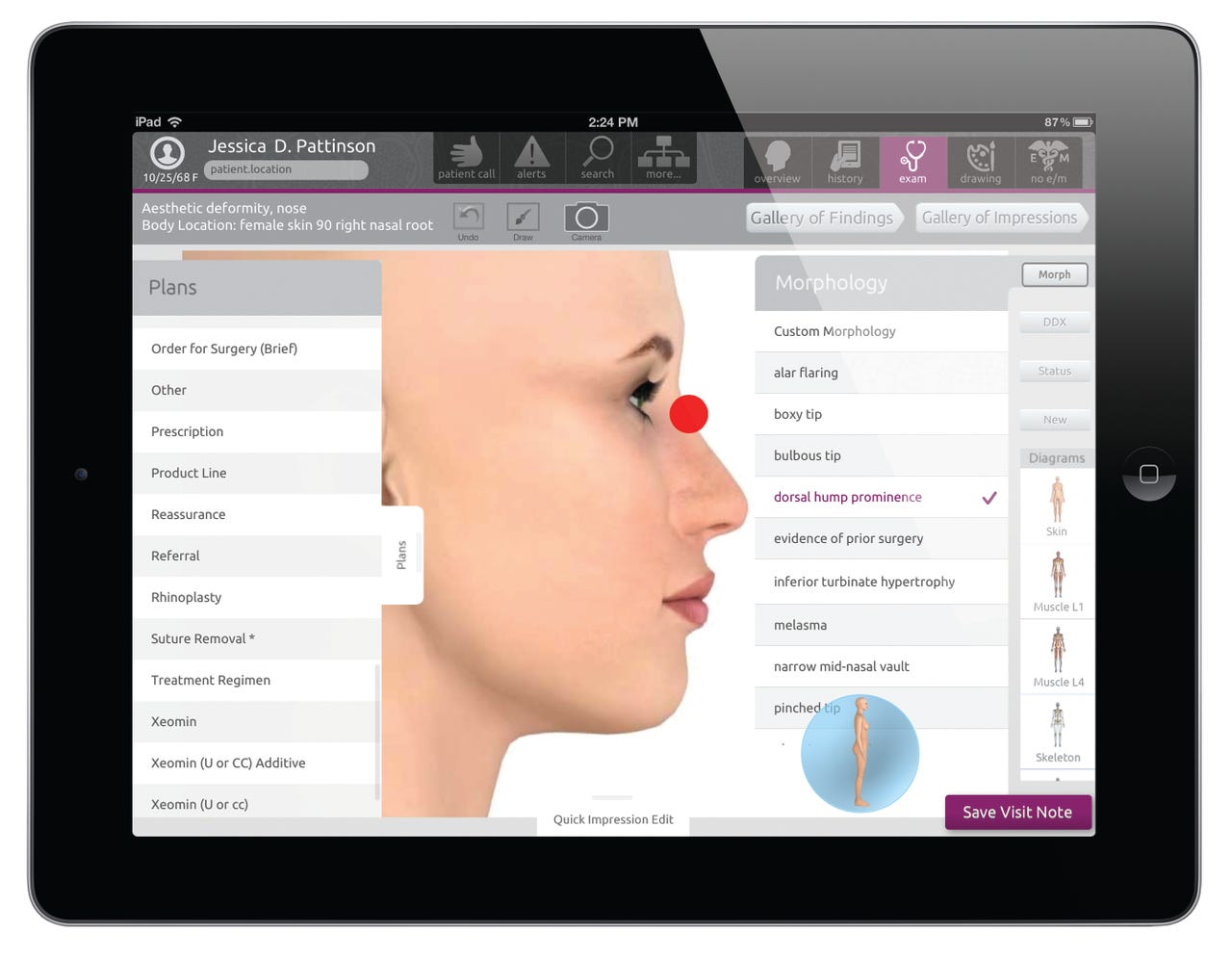The state of the 'Industry Cloud' in the healthcare sector


For the last two decades, the push in the healthcare industry has been to simply digitize records, where physicians and their staff take an analog patient chart and enter the data into a computer.
But it lacked the influence of cloud, or mobile, or big data. The industry was trying to build a solution that worked for every type of medical facility -- from hospitals, to urgent care centers, to clinics, to home health companies, to private practices. Of course it would have to be a generic solution, and so by its very nature it wouldn't be as efficient as it could be.
"The demands on the software from the medical perspective were so vast that people just defaulted to having lowest common denominator -- one size fits all systems," said Dan Cane, co-founder and CEO of Modernizing Medicine, a cloud company that's changing the way Electronic Health Records (EHR) work by making the process more specialized and interactive by adding AI, adaptive analytics, and more specific data analysis.
Problem was, that meant a system that looked an awful lot like a word processor, with no real advanced IT behind it. So sticking a doctor in front of a computer screen, with a keyboard, mouse, and blank page -- that has been daunting and unnatural for them.
But give them an iPad app and tell them that's the only IT they need -- no server rooms, no wires and clunky systems -- and they're into that. That can make a physician's job easier and faster. It also means access to a wider array of smarter information, more ways to research diseases and illnesses, and the opportunity to save time in an industry that values seconds more than anything else.
Healthy cloud and SaaS penetration
A 2014 survey of healthcare providers by Health Information and Management Systems Society's (HIMSS) Analytics subdivision showed that 83 percent of IT healthcare executives said they were using cloud services. And 67 percent of IT healthcare organizations at the time were running SaaS-based applications.
According to the report, the main reasons for cloud services were: hosting clinical applications and data, backups and data recovery, and health information exchange. Most of the organizations -- about 37 percent -- reported they used a private cloud, though about 36 percent used a hybrid model, and about 23 percent used a public cloud.
"Healthcare providers' growing infrastructure, system and support requirements -- compounded by tight budgets and IT staffing issues -- will continue to drive them toward a hybrid IT environment in which the cloud will play an increasing role," said Barry Runyon, a research VP for Gartner who focuses on the healthcare sector.
Runyon added that healthcare providers use public cloud services for things like email, content management, medical image archiving, medical record systems, health information exchanges, portals, natural language processing, enterprise content management, secure texting, clinical collaboration, transcription services, mobile device management, analytics, legacy decommissioning, and disaster recovery.
"My sense is that a significant percentage of the healthcare providers' workload will move to the cloud in the next 5-10 years," Runyon said. "The healthcare provider has been taking measured steps toward the cloud over the past few years and while it hasn't embraced the cloud entirely, it has accepted the fact that it has its place and will play a bigger role in IT service delivery in the next few years as cloud service providers mature."
According to HIMSS, the top reasons that healthcare providers are adopting cloud technology are: lower maintenance costs, speed of deployment and lack of internal staffing resources, and CIOs have become more comfortable over time with the cloud as a viable IT option. And software as a service (SaaS) continues to lead cloud market adoption, above infrastructure-as-a-service (IaaS), which uses third-party hosted hardware and software, or platform-as-a-service (PaaS), which is used in more collaborative healthcare projects.
There are a couple types of services that industry cloud providers can offer: a community healthcare cloud, which allows a few organizations with similar interests to use the same service; a private cloud, for one entity to use as their own platform, with no other organization's information involved.
Some well-known healthcare cloud providers include Athenahealth, which is a cloud-based EHR system that also focuses on medical billing, patient engagement, and order management, or Allscripts, which offers many solutions, analytics, and insights for EHR in hospitals around the world.
And of course, there are the big-name leaders in the industry, including Oracle, SAP, and IBM, which all offer end-to-end solutions like data management and clinical data aggregation for healthcare records. According to the Oracle website, the company runs the technology for 70 percent of the top multi hospital systems in the US, and more than 350 healthcare providers use their application system. SAP, for example, offers EHR services, healthcare analytics, and health information exchange (HIE).
Although these IT giants offer solutions that have been proven to work well, the smaller names in the healthcare cloud industry are gaining traction because of how flexible they are. Modernizing Medicine, for example, has a team of doctors who frequently update and analyze the data they gather, and specialized practices, like ophthalmology or dermatology, get more specialized, user-specific data. And, with smaller service providers, changes can be made faster and more efficiently, and physicians can talk to the company more intimately about changes they would like to see made. Another added benefit of smaller providers is that they are not as obvious a target for hackers.
Healthcare data concerns
With medical data comes many concerns about security, privacy, and reliability. Privacy is, of course, a huge issue for healthcare providers when they decide to implement a cloud-based system. One of the most important things for a cloud service to show is that they are HIPAA compliant and have had a third-party assessment.
One advantage, though, is that with traditional EHR systems, if someone were to break into the office and steal a server, it would be a nightmare. With cloud-based platforms, like for instance, Modernizing Medicine's Electronic Medical Assistant (EMA) platform, if someone walks out with the iPad, no one has lost all of that secure information. It's on a server far away, encrypted all the time.
Runyon noted some other risks in this vertical as well: "Cloud security, liability, licensing, provider lock-in, and boilerplate terms and conditions remain top cloud issues and barriers to adoption," he said.
Access is key, as healthcare cloud technology needs to be reliable all the time. Modernizing Medicine uses Amazon Web Services for its service, so the information is in the cloud, always available, and redundant in multiple data centers.
"A Netflix outage is annoying, but if you can't access medical records, it could be life threatening," he said. "The only danger of the cloud is not being able to access the cloud, but the iPads took care of that for us because they have the redundancy of a cellular connection."
Because this industry is still in its nascent stages, it's often unclear what benefits medical providers can reap from the services. What does cloud technology really offer healthcare providers, and is it worth it? That's the question many people in the industry are asking.
For Cane, cloud technology has improved efficiency and opened up a world of information. The company designed what they call an Electronic Medical Assistant, with the help of a team of 18 physicians and a team of programmers. EMA can predict what a doctor is going to do based on the information in the cloud from all the providers that use the system, as well as the habits of each individual doctor in a variety of specialities.
"Rather than assuming every doctor is the same and here's my template for treating the disease, we say every doctor is different, and we predict based on that," Cane said. "When you guess accurately, you improve productivity tremendously."
Time is the most important thing to give doctors. With patients, it's improving outcomes, and cloud technology combined with an adaptive learning system can offer both of those things. And because the cloud is full of medical information from providers all over the country, physicians can benchmark themselves and look at medical trends in real-time using any type of filter, like age, gender, or race.
"If you combine data with cloud, you have wisdom," Cane said.
Although many healthcare providers have been reluctant to adopt the technology, Runyon said, it's growing quickly as they see these sorts of benefits come from the innovations in the IT industry.
"As an overarching architecture and service delivery model, I believe the cloud is uniquely positioned to address care coordination, clinical communications and collaboration and patient engagement requirements," he said.